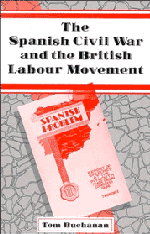Book contents
- Frontmatter
- Contents
- Preface
- List of abbreviations
- Introduction: ‘The Spanish problem’
- 1 ‘The best that could be done at the time…’: Non-Intervention, 17 July–28 October 1936
- 2 Breaking with Non-Intervention: October 1936–October 1937
- 3 The failure of the left: October 1937–April 1939
- 4 ‘A demonstration of solidarity and sympathy…': The Spanish Workers' Fund and its competitors
- 5 Opposition: Catholic workers and the Spanish Civil War
- 6 Rank-and-file initiatives
- Aftermath and conclusion
- Bibliography
- Index
Introduction: ‘The Spanish problem’
Published online by Cambridge University Press: 05 January 2012
- Frontmatter
- Contents
- Preface
- List of abbreviations
- Introduction: ‘The Spanish problem’
- 1 ‘The best that could be done at the time…’: Non-Intervention, 17 July–28 October 1936
- 2 Breaking with Non-Intervention: October 1936–October 1937
- 3 The failure of the left: October 1937–April 1939
- 4 ‘A demonstration of solidarity and sympathy…': The Spanish Workers' Fund and its competitors
- 5 Opposition: Catholic workers and the Spanish Civil War
- 6 Rank-and-file initiatives
- Aftermath and conclusion
- Bibliography
- Index
Summary
The fall of the Spanish monarchy in 1931 and its replacement by a progressive, democratic Republic was welcome news to the British labour movement, coming at a time of world economic depression and political failure for governments of the left. The appointment of three leading Spanish socialists as ministers in the first Republican government and the rapid expansion of Spanish trade unionism appeared to herald not only a new era in Spain's history, but also a transformation in the international standing of Spanish labour. For the leaders of British labour, who for years had seen it as a marginal European nation – poor, socially and politically backward – Spain could seemingly no longer be ignored. For the Spanish, the Republic brought the opportunity to extend their previously slender links within the confraternity of international labour. Yet this new dawn proved illusory. By 1933 the socialists were out of office and, within a year, had participated in a failed insurrection against the new centre-right government. By the time the left had returned to power by legal means in February 1936, as a broad Popular Front stretching from the anarchists to the middle-class Republican parties, it was too late to resolve Spain's appalling social and political tensions bloodlessly. The civil war that erupted with an army revolt on 17 July 1936 lasted until April 1939; it cost up to a million lives and at its end the Republic lay in ruins.
- Type
- Chapter
- Information
- Publisher: Cambridge University PressPrint publication year: 1991



